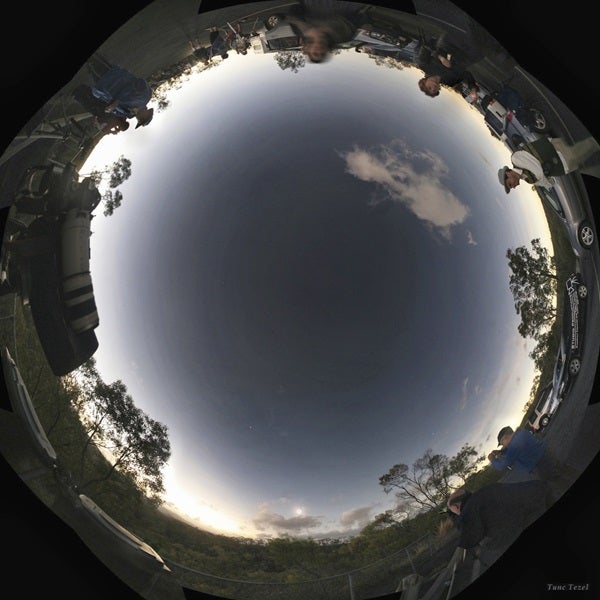This brings me to August’s total solar eclipse and a suggestion for those of you who will be standing in the Moon’s shadow for the first time: Take in the spectacle unencumbered by extra gear. Far too many people have missed totality while fussing with a camera or a telescope. My experience with my first total solar eclipse — the one that crossed much of Canada on July 10, 1972 — should prove the point.
At the time, I was on the staff of the Alice G. Wallace Planetarium in Fitchburg, Massachusetts. The planetarium had organized a few expeditions to view the eclipse. While several people went to Nova Scotia, I was part of a foursome that traveled to Prince Edward Island. Accompanying me were high school science teacher Nick NiCastro, local radio broadcaster Dave Svens, and chemical engineer Ray Latham. Ray had a pilot’s license and flew us to the island in a rented Cessna.
There are two parts to any solar eclipse expedition. The most obvious one is the precious few minutes of totality. But nearly as important are the days before and after the eclipse when you have a chance to explore the region around your eclipse site.
Our small group arrived July 9, and after settling in at a motor lodge, we rented a car and toured the island. The scenery was so picturesque — with quaint fishing villages interspersed with rolling, uncluttered farmland — that I returned the following summer with my wife for a weeklong vacation.
On eclipse day, we drove to a scenic location on the grounds of a church overlooking the ocean. As soon as first contact arrived and the Moon took a tiny bite from the Sun’s disk, I went to work taking periodic film clips with my Kodak Instamatic Super 8 zoom lens movie camera. (Hey, it was the 1970s. We had no camcorders back then, much less GoPros.) In between, I peered into my 60mm refractor rigged with a 20mm eyepiece and screw-in solar filter. (Hey, it was the 1970s. The danger of screw-in Sun filters cracking at any second wasn’t well publicized.)
My mistakes occurred during the precious seconds of totality. To begin with, I was so busy fussing with last-second details that I don’t even remember the onset of totality. While frantically unscrewing my solar filter so I could view the eclipsed Sun through my telescope, I happened to look up and saw the most amazing sight: The entire horizon was draped in a salmon pink sunrise-like glow. Too bad I took in the scene only for a second or two before returning to telescope and camera. I managed some quick Super 8 shots and sketched the eclipsed Sun. All too soon, daylight returned. Having seen totality and getting to tour a beautiful island, I’d say our eclipse expedition was a rousing success. But it was that fitful time during totality that I’d love to go back and do over.
I’ll do it right this time. I’ll still bring a camera and telescope, but only to record the local scenery and do some nighttime skywatching. In the moments prior to totality, I’ll gaze westward to see if I can spot the approaching lunar shadow. During totality, I’ll soak in that 360° “sunrise” and the all-sky vista of an eclipsed Sun along with the bright planets and stars that will pop into view. There won’t be any high-power views of the Sun through a telescope for me this time!
I’m not sure it’s the best analogy, but I would compare viewing the eclipsed Sun through a telescope to “scoping” the Grand Canyon. Sure, you’ll see greater detail, but you’ll miss the jaw-dropping panorama.
What about those great eclipse photos or close-up views of the Sun that I won’t get? No problem! Plenty of veteran eclipse-chasers will be on hand to capture images far more impressive than anything I’d likely get. Within hours of the eclipse, photos will flood the internet. I’ll find plenty at Astronomy.com, and I’ll see the best in our magazine a couple of months down the road.
Besides, in seven years — April 8, 2024, to be exact — another total solar eclipse will traverse North America. This one will cut across Mexico, the United States from Texas to Maine, and the Canadian Maritimes. Totality will run from about 41/2 minutes at maximum eclipse in Mexico and southwest Texas to more than 3 minutes in New Brunswick. That’s still the blink of an eye, as any veteran eclipse-chaser will tell you. Still, you’ll have enough time to enjoy a panoramic view and take a few photos!
Questions, comments, or suggestions? Email me at gchaple@hotmail.com. Next month: some showpiece stellar pairs you missed during the double star marathon.











